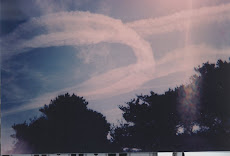
The photos to the left of the blog are just some of the photos I have taken of contrails that don't disappear. Normal contrails fade away but these get bigger and bigger until the whole sky is a hazy overcast. I have taken heat from people on other blogs about what I have photographed and seen so I am asking, is there is anybody that is an expert on these that would like to shed some light on the subject? Why do some modern contrails disappear as they should and some grow to cover the sky? This hasn't always been the case. Why?
I should note that the picture to the right and above was not taken by me.















10 comments:
Q) How long do contrails last?
A) Anywhere from less than a second, up to several hours.
This is an oft-asked question. The answer is reasonably straightforward, but misunderstanding is common. To understand why a contrail can last as little as a fraction of a second, or as long as several hours, you need to understand what a contrail is, and how it forms.
Here’s another question, which has the same answer:
snowflakecvr2.jpgQ) How long does a snowflake last?
Why is this basically the same question? Because contrails are generally made of ice crystals. Jet exhaust contains a lot of water vapor (the chemical reaction actually produces more water than there was originally jet fuel), and when this gets shot out of the back of the engine at 2000MPH, it hits the frigid air (typically colder than -40 degrees), and the water vapor condenses and freezes, very quickly, into tiny ice crystals, just like snowflakes.
So why do these ice crystals sometimes stay around for a long time, and sometimes vanish in seconds? The temperature is well below freezing, so they can’t melt, can they? This is puzzling, because it involves something that most people know nothing about: “sublimation“.
Sublimation is when a substance (in this case, water), goes directly from being solid to being vapor (a gas), without actually melting into a liquid. It’s like evaporation, except instead of a liquid evaporating, it’s a solid (ice). If the air is dry (i.e. there is little water vapor in it), then the ice crystals will quickly sublimate into vapor, and the trail will vanish quickly.
However, if the air already has a lot of water vapor in it, then the ice will sublimate slower, and the trail will last longer.
If the air has so much water vapor in it already that it can’t hold any more (i.e. it’s “supersaturated”), then the ice crystals can’t sublimate, and so the contrail will stay around for a long time. The ice crystals might even attract water from the air, if there is enough, and the contrail will get thicker. Winds might make the contrail spread out to even cover the whole sky.
The above is a simplification, as other factors like temperature, pressure, and sunlight have an effect. But it explains the basic reasons why some trails last only a few seconds, and some can last for hours, and spread out to cover the sky.
Contrails do cause an effect on our climate:
For several days following Sept. 11, 2001, planes were grounded throughout the United States. Satellite images during that time period show crystal clear skies across the contiguous United States. The clarity, researchers say, stemmed from the absence of jet contrails, and studies during that time period partly confirm what scientists have proposed over the past few decades: Contrails, a form of cirrus clouds, can change climate on short and long time scales.
If you google 'contrails, 911' reports on the study they did on the days that the skies were without planes will come up.
Have you seen this thread?
http://www.godlikeproductions.com/forum1/message13772/pg1
1768 pages of requests for a more informed host on C2C.
If Noory asked the right questions and had a basic science back ground then folks might be better informed.
I would not like to see C2C go UNLESS it could be replaced with a show that covered the same topics but in a more informed manner.
I really do appreciate the programs you have chosen to put on the air. For now Noory sucks and there is no replacement that I know of. I do trust if there is one out there you will find it.
Thanks Kathy for the insight into this contentious subject. There are so many different theories for why there are more of these in the skies than there were a dozen or so years ago. Most of them seem to be pretty far reaching. Do you know if there has been a change in jet fuel in the last 10 or 12 years that would cause more of this to happen? Could global climate change be causing these to hang around longer?
Also, from the radio station here, we can see commercial flight traffic to the east, over the mountains going north and south and the contrails always disappear within minutes. The criss cross patterns that go from the north west to the south east sometimes disappear when right behind them or a few miles to the side of them, other jets leave trails that spread out. It's as if the air at that altitude has pockets of dry warm air right next to cold moist air. I have seen these that stop and start again from the same jet. Mixed pockets of air might explain this.
Thanks again for the good info.
Why are there more contrails? To start with the obvious there are more planes. And I would check to see if the planes were not routinely flying at higher altitudes than in the years before, creating a lower temp for the contrail to live in.
Also the moisture to the west of you is going to be different than to the east of you because we are so close to the sea.
I found this site to be very useful:
http://contrailscience.com/
to be useful in getting a basic understanding of the life and times of the contrail.
Once you have at least some general understanding of the different conditions that are normal it is easier to pull out what you feel to be not normal.
But they start and stop and start again. Sometimes they have a normal or fading contrail for a few miles over the Pacific and then for 3 or 5 miles a big plume that spreads out then the trail fades. You end up seeing dashes and dots like Morse code. As they move over the land, same thing.
Once on my way to L.A. we saw dozens going north and south over the central valley and they all ended up going straight up into a point just south of Bakersfield.
No clouds, just lots of trails, it was a weird to see. L.A mountains must have changed the way they reacted. One fun thing I like to do when they are thick over Eureka is to get on the air, tell people to look up and work it into the weather forecast. They almost always move away from Eureka when I do that. They move north, south and west and stop directly over Eureka. I always feel I had something to do with them going away. Maybe it's just a coincidence. It is a fun way to use 5 thousand watts of energy though.
Gotta go now. I'll check in tomorrow. Thanks for being real and offering some good info Kathy.
Think it through, the mountains are going to effect the air currents, and temp of air currents. On the site I mentioned it shows many of the forms a contrail can take and why.
Did you know ships create contrails? Contrails are visible from space?
Check out that site and you can be your own expert.
Kathy,
That web site has better pictures than I have. Lots of reading to do. With 5,260 military flights daily, I think that's what I am seeing over Eureka. The color photo of contrails over the U.S. doesn't show any N/W to S/E contrails over Eureka the day it was taken. This should rule out commercial flights unless the snap shot is of a holiday or weekend. Fact is you don't see much jet traffic over Eureka on a daily basis. So charter or military would be responsible for most of the action I see.
Looks like you have a great question to work with: What or who is flying over Eureka?
What are the paths of the commercial flights?
I also found that site on contrail science to be extensive and informative. Enjoy!
Post a Comment